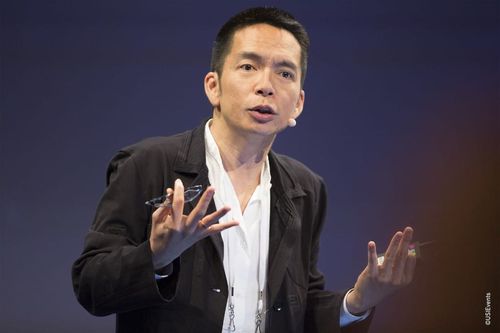John Maeda - Design at the service of leaders
As an artist and investor from the MIT, John Maeda started working on making technology and design merge early on. Considered the “Warren Buffet of Design” by Wired, John Maeda shows how design could inspire the leaders of today and tomorrow in his talk at USI.
Design can be seen in different ways, but John Maeda believes in its strength and inclusive nature for individual users as well as companies, for employees and managers alike. Design is gradually being used for product creation, but it can also bring answers or inspiration to appropriate the radical transformations underway.
Design as an answer to exponential changes
The first point is linked to the acceleration of change and its impact on business life. In 1965, the Moore law drew an empirically-verified rule according to which the power of micro-processors and electronic devices doubled every 18 months. Computers are becoming faster and cheaper and are offering potential, thus forcing large businesses and their management to think of how to use them. When looking at innovation already implemented in our society, it is clear that the past few decades have radically modified our habits.
Design is becoming an answer to the exponential changes defined by the Moore law.
The TV screen and then the mobile have radically altered the way we socialize and move around. In such a context of change, keeping an open mind seems the most appropriate way of anticipating and appropriate change. People who started working in the 1980s were lucky to observe the Moore law in action and to be exposed to most of the ideas that only today are turning out to be successes. Why is there such a gap between the idea and its implementation? There are two possibilities: either the idea didn’t develop because people didn’t trust in its success, or the idea couldn’t be implemented because there was no sufficiently developed technology or user experience. Today, according to the Moore law, technology has a reduced differential potential, so experience and design are taking a central space in business strategies. Design is becoming an answer to the exponential changes defined by the Moore law.
“Start-ups” can also envy “end-ups”
The second point to bear in mind is that, unlike popular ideas circulated at the moment, large corporations or “end-ups” should not be undermined when compared to the more agile “start-ups”. John Maeda spent most of his professional career in “end-ups”. As such, he was able to observe their weaknesses but also their strengths, what explains that they are still present and powerful today. As the recent physics Nobel Prize observes, businesses follow the same pattern as molecules: “the larger they are, the larger the impact on their ecosystem, as long as their structure is externally oriented”. Start ups are agile and have little to lose, but the major strengths of “end-ups” are to be stable, structured from the inside and to have sufficient means to carry out impacting actions. Because being able to avoid the chaos of a start-up type environment is also essential to ensure the efficiency of an organization. As John Maeda summarize: “what is the objective of a start up, if not to expand and become an “end-up”?”
Watch the complete talk on our YouTube Channel
Design is about inclusion, not aesthetics
The third point to remember is the fundamental difference between the notion of design and the notion of aesthetics and arts. Where art questions, design finds answers. Art is an enigma, something mysterious, whereas design is concrete and brings solutions. For John Maeda, design works when it meets two criteria: form and content.
Where art questions, design finds answers.
Take the example of the “comic sans” police which is generally criticized for being so generic in design: if you look at its specificities, you start looking at it in a different way. Looking at its form, you’ll notice it looks as though it is hand-written, which makes it more human, more lively, though ill-adapted to some contexts. This particular police wouldn’t be trusted if applied to a package of medication, whereas it would work particularly well in a comic book. The conclusion is that good design is a form that meets its content and therefore its context.
As such, design is essential to increase the market of a product towards more inclusion. If car sales increased after the war in the US, it is partly because of laws that were implemented in favor of developing highways (the 1952 Federal Highway Act), but the market never would have developed without the help of designers who worked on the long-distance travel experience to adapt it to families. Equally, sending an email was a tedious endeavor in the 80s, and the increase in internet use with the emergence of mobile phones in the years 2000 would not have occurred if user experience hadn’t been optimized, unless millions of users suddenly agreed to endure frequent pain. Reducing that pain or increasing comfort in transport through design is the most efficient way of increasing your base of new users, so they adopt new product uses. As such, design can be seen as highly inclusive.
You may also like :
- Our interview with Jon Kolko : "Design should be a liberal art"
- Richard Sheridan - Build a workplace people love, Just add Joy
